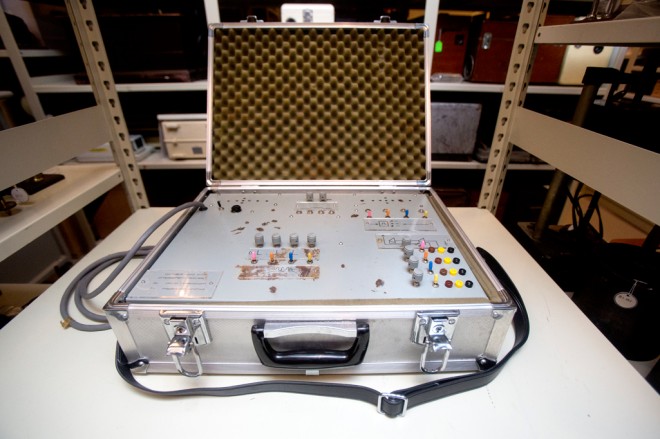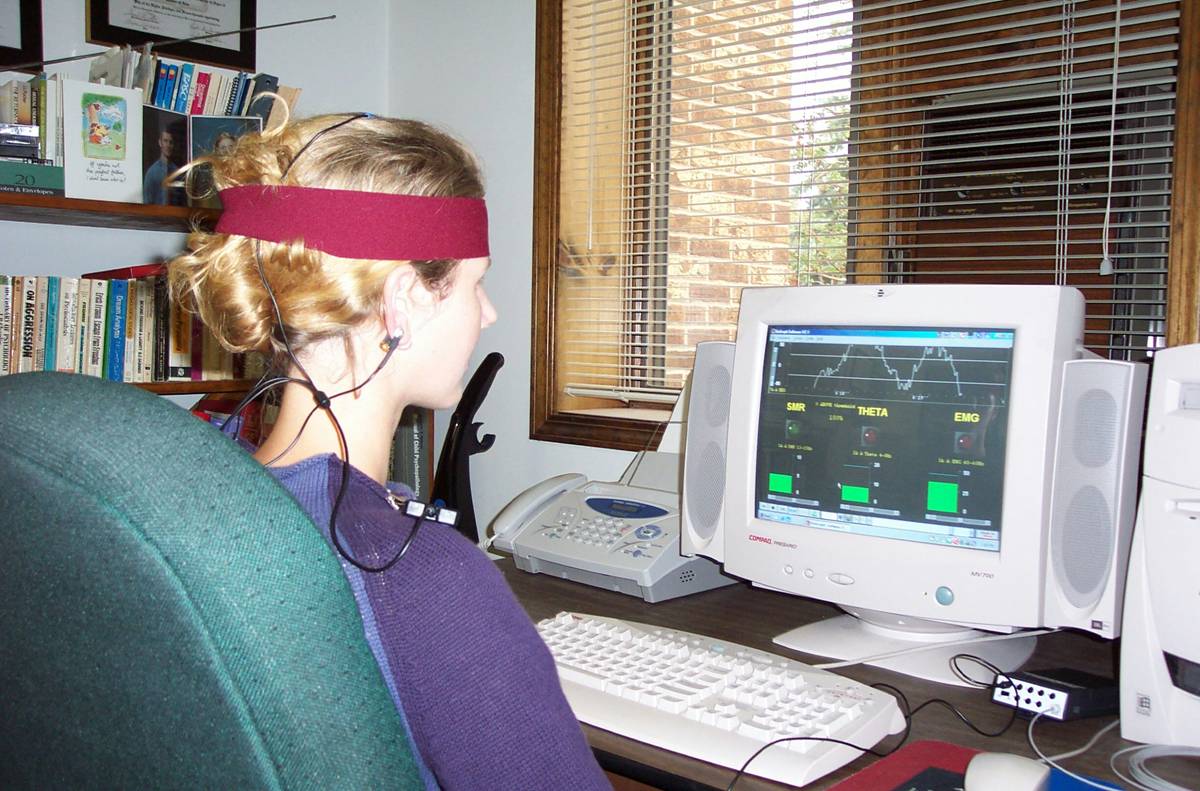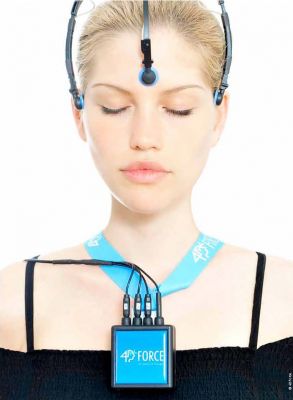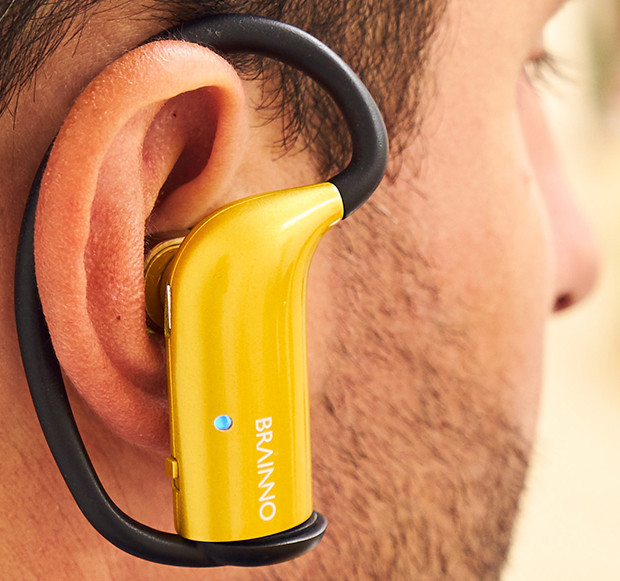Neurofeedback
List of Neurofeedback devices:
Neurofeedback (NF) stems from electroencephalography (EEG), the method of measure brain activity. Neurofeedback (also called 'EEG biofeedback' or 'brain–computer interface training') consists in providing its user information about his or her cortical activity, especially the frequency of brain waves, in an understandable way. It is supposed that the information allows him or her to change undesirable frequencies and improve his or her mental state in this way.[1] It is used as a treatment of anxiety, attention deficit hyperactivity disorder (ADHD) or for an improvement of user's mood. However, the efficacy of the therapy was not convincingly proved yet.[2]
Contents
Main Characteristics
Neurofeedback is a method in which participants learn how to influence electrical activity of their brains.[3] It is a part of biofeedback technique. Biofeedback consists in measuring different body features as temperature, blood pressure or heart rate, and learning participants to control their body processes by this knowledge. Neurofeedback focuses on the brain activity, which is measured by EEG.[4]
The brain activity is measured by electrodes in EEG. The activity is displayed in a form of brain waves. The brain waves differ in frequencies. There are four basic groups of frequencies: beta (more than 13 Hz), alpha (8 - 13 Hz), theta (4 - 8 Hz), and delta (0.5 - 4 Hz). EEG can diagnose brain death, coma, seizure, sleep disorder or alertness.[5] The aim of neurofeedback is to measure the brain activity and give a user a feedback if there are certain wrong patterns. The device delivers visual, auditive or audio-visual information which help users of neurofeedback devices to know, if they reduce the undesirable brain activity and increase the desirable one.[1]
The neurofeedback is used in medical clinics to treat ADHD epilepsy, autism, or insomnia. The treatment is, however, still experimental. The efficacy of neurofeedback has not been convincingly proven yet. There are also various non-medical clinics, which provide neurofeedback. They promised their customers reduction of certain disorders as anxiety, anger, an improvement of mood or an enhancement of cognitive skills as memory, attention, creativity, or intelligence.[6] There could be also purchased device for using neurofeedback at home.[7]
Purpose
Neurofeedback is a method used to treat neuropsychiatric disorders, by learning users how to regulate brain activity. The mothod has also potential to enhance certain cognitive skills.
Historical overview
The history of a measurement of an electrical activity of a brain began in 1875 when Richard Caton discovered that there is an electrical activity in a brain.[5] The measurement of this activity, electroencephalography (EEG) was introduced by Hans Berger between 1929 and 1938 in several papers.[8] Neurofeedback as a treatment was developed in 60s and 70s, while the research on this method was conducted primarily by the U.S. researchers. The subjects of the research were firstly cats but the researchers began the trials with human subjects soon after the introduction of the method. Neurofeedback was used for a therapeutic treatment as a reduction of seizures.[9] In 1969, Joe Kamiya claimed in an article that healthy individuals might benefit from using neurofeedback as an enhancement.[1] Joel Lubar treated a child with hyperkinetic syndrome by neurofeedback in 1976 and described a reduction of hyperactivity and distractibility in his paper based on the results of the research.[10] Lubar's study is considered the first study on the effects of neurofeedback in ADHD.[11]
Important Dates
- 1875: Richard Caton discovered electrical activity in brain of animals[5]
- 1929-1934: Hans Berger described the measurement by a EEG device[8]
- 1960-1970: the development of neurofeedback as a treatment of seizures[9]
- 1969: J. Kamiya claimed that neurofeedback could be used as an enhancement by healthy inviduals[1]
- 1976: Joel Lubar used neurofeedback as a treatment of children suffering with ADHD[11]
Enhancement/Therapy/Treatment
Neurofeedback was used as a treatment of several disorders as addiction, anxiety, autism, depression, migraine, insomnia or post-traumatic stress disorder (PTSD).[12] However, the majority of research was focused on the treatment of ADHD.
Attention Deficit Hyperactivity Disorder
Attention deficit hyperactivity disorder (ADHD) is a mental disorder, which symptoms usually appears early in the ages from 3 to 6. The disorder is characterised by inattention, hyperactivity and impulsivity. Certain patients suffer only one symptom from three previously mentioned, but the combined type is more common, especially among children. The disorder could persist during adolescence and adulthood, but its symptoms could also change. There are more male than female suffering ADHD.[13]
Among other treatments, neurofeedback was investigated as a possible treatment of ADHD. The treatment focuses of reduction of theta brain waves and increase of beta brainwaves.[14] Several studies were conducted, which claimed that there is a significant improvement of ADHD patients that had been treated by neurofeedback.[15] However, the meta-analysis which Cortese and his colleagues publish in 2016 point out that the majority of studies which claimed the efficacy of neurofeedback were not blinded. If the double-blinded studies are taken into account the efficacy of neurofeedback is not conclusive.[2] To sum up, more double-blinded studies are needed to decide convincingly if neurofeedback is beneficial for patients suffering from ADHD or not.
https://www.theguardian.com/technology/2008/feb/21/research.games
http://www.sciencedirect.com/science/article/pii/S0890856716300958?via%3Dihub
The wearable devices which are currently available are focused primarily on the improvement of meditation as Muse or Melomind. There are also devices which should improve concentration as Mindset, Hit The Gold, or Brainno, reduce the level of stress as 4DForce or improve the working memory as Melon.
Ethical & Health Issues
Efficacy of the method
https://www.wired.com/2015/05/internet-anything-brain-monitors-going-mainstream-despite-skepticism/
Another issue is linked primarily with consumer neurofeedback devices. Namely, these devices has to struggle is the accuracy of their measurement. First, the signal from the brain could be mingled with electric signal which was produced by a different part of body. Second, the consumer NF devices used dry electrodes, which are less reliable that wet electrodes used in the clinics, since the wet increases the conductivity.[16] Third, there is considerably less electrodes and amplifiers in the consumer devices than in the devices used in medical trials, which could also influence accuracy of the devices. Fourth, the interpretation of the results should be done by experts. The layman could misinterpret results he or she acquires from the device.[7]
Although neurofeedback is considered to be not as invasive as other methods of brain stimulation, certain side effects of it were reported. It could cause headache, muscle twitches, tics, mental fogginess, sleep disturbance, fatigue, anxiety or irritability. There is also risk that a long-term NF training might lead to a permanent microstructural changes in grey- and white-matter of a brain.[6]
Public & Media Impact and Presentation
https://www.psychologytoday.com/blog/brain-myths/201302/read-paying-100s-neurofeedback-therapy-0
https://www.nationalelfservice.net/mental-health/adhd/neurofeedback-for-adhd-in-children/
http://www.newsweek.com/2016/05/20/neurofeedback-brain-regulation-neuroscience-457492.html
http://www.brainworksneurotherapy.com/press/sunday-times-real-brainwave
The procedure is controversial, expensive and time-consuming. An average course of treatment, with at least 30 sessions, can cost $3,000 or more, and few health insurers will pay for it. Still, it appears to be growing in popularity.[9]
https://arstechnica.com/science/2015/11/can-you-think-yourself-into-a-different-person/?comments=1
Public Policy
Hannah Maslen and her colleagues point out that there is a regulatory gap concerning brain stimulation devices, which are used for cognitive enhancement. They suggest that these devices should be regulated as medical devices.[6]
Biofeedback units (to which belong also neurofeedback devices) are classified as Class II. devices by the Food and Drug Administration (FDA) in the U.S. It means that they require pre-market approval before their shipping in the U.S.[17]
Related Technologies, Projects, or Scientific Research
ADHD could be also treated with medication, psychotherapy, or education and training.[13]
References
- ↑ 1.0 1.1 1.2 1.3 VERNON, D. et al. Alpha Neurofeedback Training for Performance Enhancement: Reviewing the Methodology. Journal of Neurotherapy: Investigations in Neuromodulation, Neurofeedback and Applied Neuroscience, 13(4), 2009, pp. 214-227, Doi: 10.1080/10874200903334397 Available online at: http://www.isnr-jnt.org/article/view/16632 (Retrieved 1st August, 2017).
- ↑ 2.0 2.1 CORTESE, Samuele et al. Neurofeedback for Attention-Deficit/Hyperactivity Disorder: Meta-Analysis of Clinical and Neuropsychological Outcomes From Randomized Controlled Trials. Journal of the American Academy of Child & Adolescent Psychiatry, 55(6), 2016, pp. 444-455, Doi: 10.1016/j.jaac.2016.03.007 Available online at: http://www.sciencedirect.com/science/article/pii/S0890856716300958?via%3Dihub (Retrieved 1st August, 2017).
- ↑ VERNON, D. et al. The effect of training distinct neurofeedback protocols on aspects of cognitive performance. International Journal of Psychophysiology. 2003, 47(1), pp. 75-85. Doi: 10.1016/S0167-8760(02)00091-0 Available online at: http://www.sciencedirect.com/science/article/pii/S0167876002000910?via%3Dihub (Retrieved 2nd August, 2017).
- ↑ ROBERTS STOLER, Diane. What is Neurofeedback? Dr. Diane Brain Health [online]. Available online at: http://www.drdiane.com/treatments/neurofeedback/ (Retrieved 2nd August, 2017).
- ↑ 5.0 5.1 5.2 TEPLAN, M. Fundamentals of EEG measurement. Measurement Science Review, 2002, 2(2), Available online at: http://www.edumed.org.br/cursos/neurociencia/MethodsEEGMeasurement.pdf (Retrieved 3rd August, 2017).
- ↑ 6.0 6.1 6.2 MASLEN, Hannah et al. The regulation of cognitive enhancement devices: extending the medical model. Journal of Law and the Biosciences [online]. 2004, Mar. Doi:10.1093/jlb/lst003 Available online at: http://jlb.oxfordjournals.org/content/1/1/68.full (Retrieved 7th December, 2016).
- ↑ 7.0 7.1 CADDY, Becca. How mind reading wearables let us delve inside our brains. Wareable [online]. 2016, Jan 26. Available online at: https://www.wareable.com/wearable-tech/looking-inside-the-brain-2219 (Retrieved 3rd August, 2017).
- ↑ 8.0 8.1 KAISER, David A. Basic Principles of Quantitative EEG. Journal of Adult Development, 12(2/3), August 2005. Doi: 10.1007/s10804-005-7025-9 Available online at: https://link.springer.com/article/10.1007%2Fs10804-005-7025-9 (Retrieved 1st August, 2017).
- ↑ 9.0 9.1 9.2 ELLISON, Katherine. Neurofeedback Gains Popularity and Lab Attention. The New York Times [online]. 2010, Oct 4. Available online at: http://www.nytimes.com/2010/10/05/health/05neurofeedback.html (Retrieved 1st August, 2017).
- ↑ LUBAR, Joel F, SHOUSE, Margaret N. EEG and behavioral changes in a hyperkinetic child concurrent with training of the sensorimotor rhythm (SMR), Biofeedback and Self-regulation, 1976, 1(3), pp. 293–306. Available online at: http://neurofeedbackclinic.ca/journals/ADHD_ADD/adhd05.pdf (Retrieved 1st August, 2017).
- ↑ 11.0 11.1 ARNS, Martijn, HEINRICH, Hartmut, STREHL, Ute. Evaluation of neurofeedback in ADHD: The long and winding road. Biological Psychology, 2014, 95, pp. 108-115. Doi: 10.1016/j.biopsycho.2013.11.013 Available online at: http://www.sciencedirect.com/science/article/pii/S0301051113002469#bib0260 (Retrieved 1st August, 2017).
- ↑ DRUMMOND, Katie. I think, therefore I heal: the weird science of neurofeedback. The Verge [online]. 2013, Apr 18. Available online at: https://www.theverge.com/2013/4/18/4226506/can-you-train-your-brain-to-heal-your-health (Retrieved 3rd August, 2017).
- ↑ 13.0 13.1 The National Institute of Mental Health. Attention Deficit Hyperactivity Disorder. The National Institute of Mental Health [online]. Available online at: https://www.nimh.nih.gov/health/topics/attention-deficit-hyperactivity-disorder-adhd/index.shtml (Retrieved 4th August, 2017).
- ↑ GEVENSLEBEN, H., HOLL, B., ALBRECHT, B. et al. Neurofeedback training in children with ADHD: 6-month follow-up of a randomised controlled trial. European Child & Adolescent Psychiatry. 2010, 19(9), pp. 715–724. Doi: 10.1007/s00787-010-0109-5 Available online at: https://link.springer.com/article/10.1007/s00787-010-0109-5 (Retrieved 4th August, 2017).
- ↑ DRESCHLER, R., STRAUB M., DOEHNERT M., et al. Controlled evaluation of a neurofeedback training of slow cortical potentials in children with attention-deficit/hyperactivity disorder (ADHD), Behavioral and Brain Functions. 2007, 35(3). Doi: 10.1186/1744-9081-3-352007. Available online at: https://behavioralandbrainfunctions.biomedcentral.com/articles/10.1186/1744-9081-3-35 (Retrieved 4th August, 2017).
- ↑ CHEN, Angela. Can headphones train you to focus better?: Maybe not. The Verge [online]. 2017, Mar 3. Available online at: https://www.theverge.com/2017/3/3/14802936/mindset-headphones-neurofeedback-eeg-attention-focus-brain-training (Retrieved 3rd August, 2017).
- ↑ STRIEFEL, Sebastian. Potential FDA Regulation of Biofeedback. Association for Applied Psychophysiology and Biofeedback [online]. Available online at: https://www.aapb.org/i4a/pages/index.cfm?pageID=3339 (Retrieved 3rd August, 2017).




